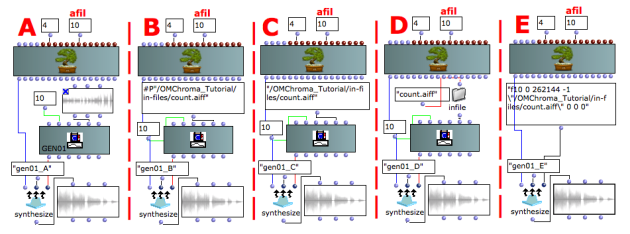GEN01 function table
Tutorial GEN01 function table
The GEN01 is a peculiar kind of GEN routine, which transfers data from a sound file into a function table.
The ordinary size of GEN tables is a "power of 2" or a "power of 2 + 1" (if the audio module is interpolating, as in OMChroma, where all the audio modules are interpolating). The maximum table size is 16777216 = 224. In the case of an audio file, this means that the amount of memory to be allocated should correspond to the "power of 2" immediately larger than the file size, otherwise the file will be truncated. This is not very optimized, since some memory will be not used and zero padded.
With some audio modules (such as flooper used in the classes smpl-5 and smpl-6, for instance) the allocation of the table memory can be deferred by setting its size to 0 (see the Csound documentation for further information concerning deferred GEN01 tables). In this case, the size allocated is the exact number of points in the file (probably not a "power of 2").
Since GEN01 routines take a lot of memory, OMChroma only allows to pass them as global tables.
The patch below shows 5 ways of initializing GEN01 tables.
WARNING: the classes smpl-1 and smpl-2 read a sound file directly from the disk, and therefore do not require a GEN01 to be initialized. This is useful when reading large sound files, but will considerably slow down the computation, as it makes a disk access for each element of a synthesis class.
This patch shows how to initialize a GEN01 as a global table.
In the examples A, B, C and D the GEN01 is initialized by a GEN01 class, passed to synthesize's keyword :tables. The sound file count.aiff is given to the GEN01 class by means of:
- A) A sound class
- B) The absolute path of the file (lisp) - do not forget to write your own absolute pathname!
- C) The absolute path of the file (text) - do not forget to write your own absolute pathname!
- D) The in-file function.
In the example E the GEN01 is passed directly to synthesize's keyword :tables and uses the Csound syntax.
Warning: Beware of the backslash character to use the double-quote character within a text string (the Csound score needs a path within double quotes).
If the workspace you are using is not named "OMChroma_Tutorial", type your own workspace's name and path at the place of the written paths.
- OMChroma User Manual
- System Configuration and Installation
- Getting started
- Managing GEN function and sound files
- Local tables
- Global tables
- Global tables vs. local tables
- GEN01 function table
- How to pass sound files
- Predefined Classes
- User-fun
- Creating a new Class
- Multichannel processing
- Appendix A - Common Red Patches

